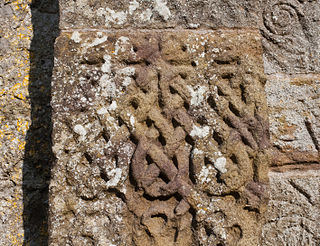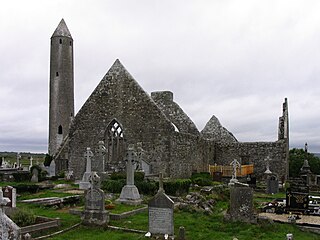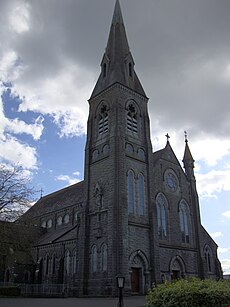
Eyrecourt, historically known as Donanaghta, is a village in County Galway, Ireland. Eyrecourt is on the R356 regional road 12 km west of the Banagher bridge over the River Shannon.
The Bishop of Clonfert is an episcopal title which takes its name after the village of Clonfert in County Galway, Ireland. In the Roman Catholic Church it remains as a separate title; but in the Church of Ireland it has been united with other bishoprics.

Clonfert is a small village in east County Galway, Ireland, halfway between Ballinasloe and Portumna. The village gives its name to the Diocese of Clonfert. Clonfert Cathedral is one of the eight cathedral churches of the Church of Ireland, Diocese of Limerick and Killaloe. The cathedral of the Roman Catholic Diocese of Clonfert is located in Loughrea and is home to the Shrine of Our Lady of Clonfert. Three churches lay in this parish, St. Brendan's Eyrecourt, St. Francis Meelick and Clonfert. Its current parish priest (2021) is Fr. Declan McInerney and its bishop Michael Duignan.

Clonfert Cathedral is a cathedral of the Church of Ireland in Clonfert, County Galway in Ireland. Previously the cathedral of the Diocese of Clonfert and then one of three cathedrals in the United Dioceses of Limerick and Killaloe, it is now one of five cathedrals in the Diocese of Tuam, Limerick and Killaloe.

St. Joseph's College, Garbally Park is an Irish voluntary Catholic secondary school situated in Garbally Park, the former seat of the Earl of Clancarty, near Ballinasloe in County Galway. It is a single-sex boys day school which has previously served as a boarding school. It is more commonly known as Garbally College.
Mullagh is a parish in the Roman Catholic Diocese of Clonfert in County Galway, Ireland. It is in the south-east of the county, close to the towns of Loughrea, Ballinasloe, and Portumna. Mullagh lies in the civil parish of Abbeygormacan, and spans the townlands of Mullagh Beg and Mullagh More.

The Diocese of Galway, Kilmacduagh and Kilfenora is a Latin Church diocese of the Catholic Church in the west of Ireland. It is in the ecclesiastical province of Tuam and is subject to the Metropolitan Archdiocese of Tuam. The deanery of Kilfenora, previously a diocese in its own right, lies in the ecclesiastical province of Cashel. The ordinary is Bishop Michael Duignan who was appointed on 11 February 2022.
The Bishop of Limerick, Killaloe and Ardfert or the Bishop of Limerick and Killaloe is the Church of Ireland Ordinary of the united Diocese of Limerick and Killaloe in the Province of Dublin. Since 2022, the bishop has been Michael Burrows.

The Diocese of Limerick and Killaloe was a former diocese of the Church of Ireland that was located in mid-western Ireland. The diocese was formed by a merger of neighbouring dioceses in 1976, before itself merging with the neighbouring Diocese of Tuam in 2022 to form the Diocese of Tuam, Limerick and Killaloe.

Brendan Kelly is an Irish former Roman Catholic prelate who served as Bishop of Galway and Kilmacduagh and Apostolic Administrator of Kilfenora between 2018 and 2022.
The Bishop of Kilfenora was a distinct episcopal title which took its name from the village of Kilfenora in County Clare in the Republic of Ireland. In both the Church of Ireland and the Roman Catholic Church, the title is now united with other bishoprics.
The Bishop of Clonfert and Kilmacduagh was the Ordinary of the Church of Ireland diocese of Clonfert and Kilmacduagh, comprising the southern part of County Galway and a small area of County Roscommon, Ireland. In 1834, Clonfert and Kilmacduagh became part of the united bishopric of Killaloe and Clonfert.

The Bishop of Kilmacduagh was an episcopal title which took its name after the village of Kilmacduagh in County Galway, Ireland. In both the Church of Ireland and the Roman Catholic Church, the title is now united with other bishoprics.

Kilfenora Cathedral is a cathedral of the Church of Ireland. Part of the structure is occasionally used as a place of worship by the Church of Ireland and it includes a bishop's throne among its furniture. The church is located in the village of Kilfenora, in the region known as the Burren, County Clare, Ireland. In medieval times, it was the episcopal see of the Bishop of Kilfenora.
In persona episcopi is a Latin expression used by the Roman Catholic Church to indicate a union of two or more dioceses in which the dioceses are administered by a single bishop but undergo no alteration to their diocesan structures. In its mildest form such a union can be temporary, but in other cases it can be an intermediate step towards a union aeque principaliter or a full union.

The Cathedral of St. Brendan, Loughrea, is the cathedral church of the Roman Catholic Diocese of Clonfert. Though designed in neo-gothic style, it arguably houses the most extensive collection of arts and crafts and Celtic Revival artifacts of any single building in Ireland. Its most noteworthy feature is the extensive collection of stained glass windows by the Dublin-based An Túr Gloine studio. There are also twenty-four embroidered banners, mostly depicting Irish saints as well as vestments by the Dun Emer Guild. Sculptors represented are John Hughes (sculptor) and Michael Shortall, and the architect William Alphonsus Scott also contributed designs for metalwork and woodwork. The foundation stone was laid on 10 October 1897 and the structure was completed in 1902; most of the interior features date from the first decade on the twentieth century with the exception of the stained glass windows which continued to be commissioned up until the 1950s.

Michael Gerard Duignan is an Irish Roman Catholic prelate who has served as Bishop of Clonfert since 2019 and additionally as Bishop of Galway and Kilmacduagh since 2022.

The Diocese of Tuam, Limerick and Killaloe is a diocese of the Church of Ireland that is located in the west of Ireland. The diocese was formed by a merger of the former Diocese of Tuam, Killala and Achonry and the former Diocese of Limerick and Killaloe in 2022, after the retirement of the separate dioceses' bishops and the appointment of Michael Burrows as bishop of the united diocese. It is in the ecclesiastical province of Dublin. It is one of the eleven Church of Ireland dioceses that cover the whole of Ireland. The largest diocese by area in the Church of Ireland, it covers all of counties Clare, Galway, Kerry, Limerick and Mayo, plus parts of counties Cork, Sligo, Roscommon, Offaly, Laois and Tipperary.














